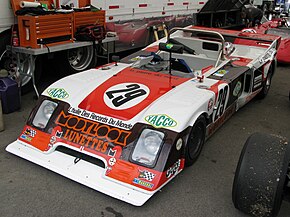Chevron B36
The Chevron B36 was a sports car prototype that was developed at Chevron Cars in 1976 and was used in sports car races until 1987.
Development history
In the Chevron nomenclature, the B36 followed the B35 . However, this was not a sports car, but a Formula 2 vehicle that was also available as a Formula Atlantic model, slightly modified . At Chevron, the vehicles were simply numbered, regardless of which racing formula they were built for.
The B36 was designed for the 2-liter class of sports car racing and was a conventional racing car without major innovations. Since it was intended for sale only, it also had to be easy to maintain. It also had to be possible to use different types of engines. The first chassis delivered were powered by a 2-liter, 4-cylinder ROC Chrysler Simca unit . Subsequently, the 4-cylinder BDA engine from Cosworth , a Wankel engine from Mazda , the M12 4-cylinder engine from BMW , a 2-liter engine from Ford and a 4-cylinder engine from Hart Racing Engines built into B36. Larger displacement engines were also used. For example, the Frenchman José Thibault fitted his B36 with a 3-liter 6-cylinder PRV engine from Talbot at the 1987 24-hour race at Le Mans . Thibault's car was a special example. It was the only B36 with a closed body; all other B36s were open Spyder. The fairing front and rear wheels were a special feature of this B36.
Between 1976 and 1978, 21 chassis were completed and delivered at Chevron.
Racing history
The racing history of the B36 chassis is extensive and diverse. Originally designed for the 2-liter class of international sports car races, some vehicles also came to Japan and North America. Overseas, some chassis have been adapted to the regulations of the Canadian-American Challenge Cup , in Europe to those of the Interseries .
Between 1976 and 1987 B36s were entered in 164 races; this racing car model received a total of 297 entries. In addition to eleven overall wins, eight class wins were also achieved; more than 60% of the reported B36 also saw the checkered flag.
The car made its racing debut at the Monza 4-hour race in 1976 , a race in the sports car world championship that year . Two B36s were registered for this race; the car with the starting number 38 by the Italian Giuseppe Piazzi - driven by Piazzi himself and his compatriot Sandro Cinotti , as well as the car with the number 39 by the French Racing Organization Course. There sat François servanin and Laurent Ferrier at the wheel. Both vehicles did not finish. The first finish came two weeks later at the Targa Florio, where Giovanni Iacono and Vito Veninata finished the race in 36th place overall. The 1977 Targa Florio saw the first race win. Like the race last year, this was part of the Italian Group 6 championship. The car was driven by Raffaele Restivo and Alfonso Merendino .
Most starts with B36 recorded the two Japanese Hiroshi Fushida and Yōjirō Terada , who drove it regularly in the Fuji Long Distance Series . The last race victory of the B36 was achieved in July 1984 by the two Britons Ray Bellm and Mike Wilds in a race for the Thunderports series in Thruxton . The last race was the one mentioned by José Thibault in 1987 at Le Mans, which ended prematurely after 18 laps due to an accident.
